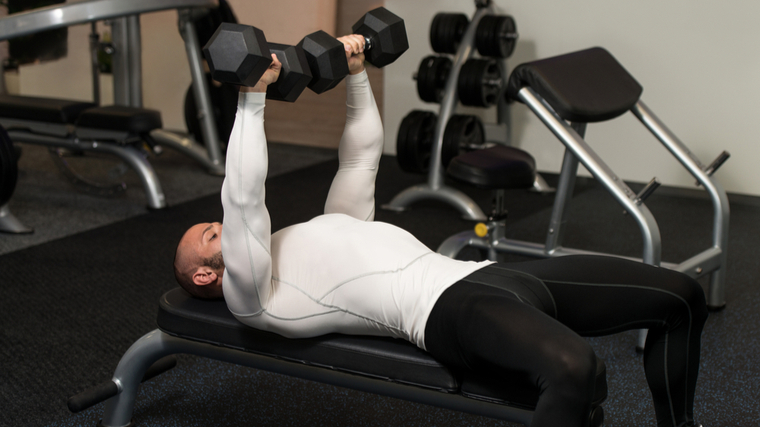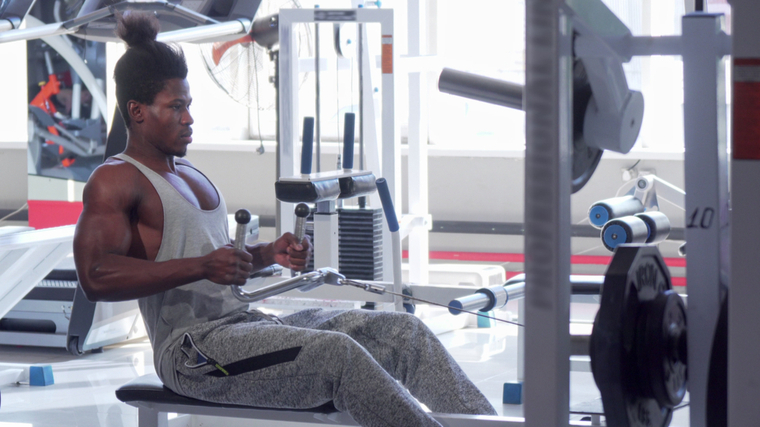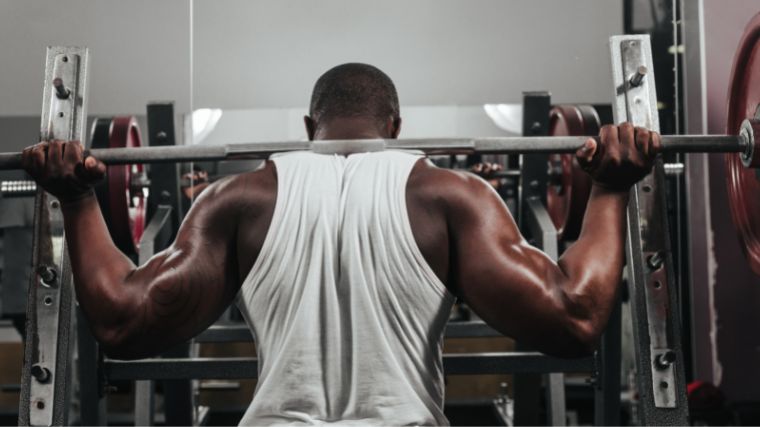If you have the luxury of working out, you’re squandering the opportunity by walking into the gym without a plan. To avoid wasting your time with marginally effective training, you need to get organized. You need a plan.

A workout split (also called a “training split” or simply a “split”) provides order to your lifting schedule over the course of a week. There are splits that train your entire body, head to toe (or traps to calves) in each session, some splits work each individual body part on its own, and then there are various combination in between.
We’ll break down the most common splits and help you to determine which is best suited for your goals.
Perfect Splits
- Common Workout Splits
- All Roads Lead to Rome
- Linchpins of Adaptation
- How to Choose the Best Split For Your Goal
- Build Up to It
Common Workout Splits
Put simply: A workout split is jargon for how you divvy up your week’s worth of training. Just like there are a multitude of exercises to choose from, there are plenty of different training splits to set the framework of your training week. While some splits share overlapping benefits, or hindrances, each might be the right choice depending on your specific goal, individual needs, and other deciding factors.
Body Part
As the name implies, this split is characterized by focusing on a specific body part or muscle group with each workout. Although many variations on the body part split are possible, the “bro split” is most widely known — a week typically looks like:
- Monday: Chest (Monday is “international chest day, of course)
- Tuesday: Back
- Wednesday: Legs
- Thursday: Arms
- Friday: Shoulders
- Saturday: Abs (or rest)
- Sunday: Rest or Cardio
Focusing on one body part at a time allows for a variety of exercises. For example, one might hit bench press, incline bench, and cable crossovers on chest day; or barbell curls, hammer curls, and a variety of direct triceps training as an arm workout. Typically, each body part receives a single training session per week.
This is a popular split among bodybuilders — competitive and hobbyists — as a body part split delivers more volume to the muscle, which is a requirement for hypertrophy (or muscle growth).
Upper/Lower
This is a two-way split. All upper body lifts are performed on day one and all lower body lifts are done on day two. The upper/lower split is commonly repeated twice per week, which would allocate four days to lifting and three days of “rest” (either non-lifting activity or total rest).

For high-frequency devotees, advanced trainees, and those pushing for short periods of over-reaching, the upper/lower split can be repeated three times per week with a single rest day. The upper/lower split, therefore, allows either two or three workouts per major muscle group each week.
Trainees will perform fewer exercises per muscle group per workout compared to the body part split. Instead of doing three to four chest exercises, you may perform two. However, because you’re training your entire upper body and lower body twice (or, in extreme cases, thrice) weekly, the overall volume stays about the same.
Push/Pull/Legs
This is another common option for physique-focused lifters, as well as those prioritizing strength. On day one, the lifter hits upper body pressing movements and triceps accessory exercises — bench press, overhead press, skull crushers, etc.
Day two includes upper body pulling — deadlifts, rows, pulldowns, curls, and company. All lower body training is reserved for day three, which is essentially “leg day” for training the quadriceps, hamstrings, and calves.
The push/pull/legs split may be repeated twice per week, which would allow a single day for “rest,” or it can be performed with a rest day between each workout. Major muscle groups are trained once or twice per week in the push/pull/legs split.
Chest & Back/Legs/Shoulders & Arms
Here’s a unique three-way split. One advantage it offers is the ability to integrate agonist-antagonist supersets, a time-efficient programming technique that alternates exercises which target muscle groups on directly opposite sides of the body (like chest and back). For example, you’d perform one set of bench presses followed by a set of rows.
This split is commonly performed once or twice per week. Therefore, each muscle group is directly trained once or twice per week. You should recognize, however, that shoulder and arm muscles tend to get “bonus” training volume because they are indirectly trained and unintentionally recruited during the chest and back workout.
Total Body
Whole-body routines aren’t technically “splits,” because they don’t divide training by body part or movement pattern. All major muscle groups are trained each session. Whole-body training is a relatively common way to train for serious athletes and beginners alike.

Three whole-body workouts per week is standard, but some lifters get by with two or four, depending on their recovery ability. As you might expect, training the entire body doesn’t leave much time for “fluff,” redundancy, or isolation work.
Whole-body routines tend to emphasize big multi-joint exercises with minimal accessory exercises. While some trainees hit whole-body workouts four or more times per week, the typical whole-body training frequency is three times per week with 24 hours or more recovery between sessions.
All Roads Lead to Rome
If you are consistently hitting the iron and training each muscle group hard — even just once or twice per week — you are virtually guaranteed to make gains. (1)(2) (Your diet needs to be in check, too.) Although many variables play relatively smaller roles, the major drivers of adaptations to resistance training are intensity, or the amount of weight lifted, and weekly volume (the total number of sets and reps). (3)
Broadly, your workout split is a method of determining frequency. Frequency can be defined as the total number of workouts per week or, in this case, the total number of sessions each muscle group is trained per week. (2)

Working on adding muscle mass or boosting strength? Dozens of training studies indicate that per-muscle-group training frequency does not significantly affect hypertrophy and strength when intensity and volume are held constant.(2)(4)(5)(6) Meaning, if all else is equal, your split shouldn’t “theoretically” matter.
More interested in fat loss? Simply adding resistance training is likely to improve body composition. (7) This effect is robust enough to occur in the absence of dieting and across a wide range of programming variables (e.g. volume, intensity, frequency of exercise). (7) Though, dialing in your diet would only expedite and enhance your progress.
It does seem any road will get you to ancient Rome, but wouldn’t you prefer to arrive looking more like a Spartan than an Athenian? (Historical spoiler alert: Yes, you would.)
For exceptional results, simply “making gains” isn’t enough. You’re looking for the most efficient path to the best possible improvement, and you’re going to need the best possible workout split for your needs.
Linchpins of Adaptation
Many factors certainly interact to determine the effectiveness of a program. For hypertrophy — building more muscle — volume (weekly sets x reps) appears to be the most important programming variable to maximize. (3)(8)

Training intensity (weight/load or nearness to muscular failure) is the crucial driver when strength is the priority. (9) Volume earns an honorable mention, as it is a more important determinant of strength adaptations than frequency. (4)(5)(6)
For fat loss goals, volume and intensity interact to stoke the metabolism during training and burn extra calories after training via the EPOC phenomenon. (10) Training major muscle groups regularly during periods of dieting can even accelerate improvements in body composition by promoting fat loss and muscle gain. (11)
Let’s consider how specific workout splits can help you to maximize the key variables for your goal.
How to Choose the Best Split for Your Goal
If you want to use a body part split, push/pull/legs, or chest & back/legs/shoulders & arms split but can only get to the gym twice per week, you’re going to leave body parts neglected and potential gains unrealized.
The first question when identifying an ideal workout split should be, “How many strength training workouts per week am I able to realistically perform?” Don’t force a square peg into a round hole. Your training split will only be effective to the extent to which it gets done.

If you can only train once per week, you’re on the full-body split. End of conversation. Go train everything, enjoy your workout, rest a lot, and come back again next week. There’s simply no other effective option for these desperate times.
If you can train twice per week, whole-body routines and upper/lower splits are potential options. This is how you can make the best of a near-minimal situation.
If you can train three to four times per week, your options open up to at least one cycle of any of the common splits except the body part split. To avoid neglected areas, body part splits should be reserved for trainees who can commit at least five days per week in the gym.
Ultimately, if you can train six days per week, the world of splits is your oyster. Once you’ve explored your schedule demands, you know your potential split options. Now, it’s time to identify the linchpin programming features for your training goal — the most essential determinants of success and identify a training split that maximizes them.
Workout Splits for Hypertrophy
As previously established, weekly volume is a key determinant of muscle growth. Although training frequency does not seem to affect outcomes when volume is equal, a split program that facilitates more volume each week may be more effective for hypertrophy. (2)(3)(8)
So, how much volume per muscle group should one shoot for? And how can they best achieve this target? Expert consensus maintains a minimum of 10 sets per muscle group in the six to 20 rep range is a viable target for hypertrophy training. (12)
Although there is potential for even more significant improvement if the additional volume is achieved, no more than 10 sets per muscle group should be programmed in a given session. (12)

From here, deciding your split is about simple arithmetic and a slight personal preference. A lifter can hit the base recommendation of 10 sets by training with a body part “bro” split. Note that 10 hard sets per body part won’t tickle — especially on leg day with (presumably) 10 sets for quads, 10 for hamstrings, 10 for calves.
Intermediate and advanced trainees can typically tolerate a body part split because they will get a whole week to recover before hitting the same muscle group again. The downside is that this split can quickly hinder volume progression if the 10 sets per day maximum warning is observed.
Whole-body split practitioners can get away with doing a moderate volume (e.g., three to four sets) of everything three days per week. This quickly becomes a long and arduous workout but can be accomplished more efficiently if agonist/antagonist or alternate peripheral superset techniques are employed.
Split training is popular among bodybuilders and likely for a good reason. A whole-body approach has been marginally less effective for hypertrophy than a volume-equated split routine. (13)
Hitting the gym four or six times per week on an upper/lower split can be very effective for hypertrophy. However, seeing too many “leg days” on the schedule can be demoralizing for a specific subset of the lifting population (i.e., the would-be skippers of leg day). And no split is effective if you’re skipping out on it.
The push/pull/legs or chest & back/legs/shoulders & arms splits are also highly effective for hypertrophy. Mentally, each day has a target — to “pump and annihilate” a given muscle or muscle group. These splits have the added advantage of facilitating time-saving and effective agonist/antagonist superset techniques.
Workout Splits for Strength
Compared to a volume-matched split routine, a whole-body routine at four sessions per week frequency has been shown to result in superior strength gains. (13)
Now, the differences in strength improvement between groups were small and failed to reach “statistical significance” for most measurements. But this finding is odd, considering that meta-analyses have reported “no difference” between volume-equated training when training frequency is manipulated. (4)(5)
Perhaps there are neurological or endocrine benefits to the whole-body training stimulus? We don’t know. But we do know this — strength training is largely intensity-driven.
A split that gives each workout a defined focus anecdotally allows the lifter to perform with higher intensity. So, if your intensity has been slipping toward the end of your whole-body routine, it’s time to consider a split.

A movement pattern-based split like push/pull/legs works great for some. For others, upper/lower provides each workout with enough focus to maximize each lift.
Workout Splits for Fat Loss
Whole body routines tend to focus on multi-joint exercises targeting large muscle groups. To train all major muscle groups in one session, whole-body workouts are to be longer in duration. These features may be beneficial to those with body composition or fat-loss goals.
Excess post-exercise oxygen consumption (EPOC) describes the increased metabolic activity, or calorie burn, that occurs following exercise. Higher intensity and longer duration resistance training or interval training tend to stimulate greater EPOC.
Although the practical benefits of EPOC have been questioned, some research has reported a greater than 10% boost in resting metabolic rate at 14-hours after whole-body strength training. This equated to an extra 168 calories burned on average, which is quite relevant when added up over several days per week. (10)

The whole-body strength training EPOC workout wasn’t a walk in the park — four sets of five exercises (squat, chest press, pulldown, shoulder press, and split squat) were performed for 30 seconds each (6-7 reps) at 80% of the lifters’ one-repetition maximum with one-minute rest between each movement. The majority of fit lifters will require 48 to 72-hours of recovery after a workout of similar intensity and volume.
Combined with a high-protein, calorie-reduced diet, whole body strength training produces superior results to dieting or lifting alone. (11) Three sessions per week were enough to elicit this effect. But don’t turn your whole-body workout into a cardio session.
The use of heavy loads (e.g. heavier than 80% 1RM), at least intermittently, is also suggested during a dieting phase. As bodybuilders in “cutting phases” know well, heavy strength training can help to protect lean mass during periods of calorie deficit.
For body composition and fat loss, the whole-body approach checks all of the boxes. Ideally, hit all major muscle groups three days per week with at least 48 hours between sessions. If you’re able to train more often than three days per week, steady-state aerobic exercise or HIIT workout may be programmed on non-lifting days.
Building Up to It
You’ve seen many recommendations for training volume and intensity in this article, but it’s prudent to gradually increase training volume and intensity instead of diving head-first into a drastically different training program.

A good rule of thumb is to limit increases in weekly set volume to 20% of previous regular volume per month. (12) For example, a lifter who previously trained with eight sets of chest exercises per week might gradually increase to 10 sets over the course of the next four weeks.
For lifters who are not accustomed to high intensity training, it’s also sensible to gradually expose your body to heavy weights over time (e.g. 2 to 4% increase per week). Deloads may be programmed as needed.
Split it or Hit it
Deciding on a training split doesn’t need to be overly complicated. It comes down to knowing your training goal, determining how often you’ll consistently show up to train, and establishing the framework for your program. Once you identify the “perfect” split for your lifestyle and training goals, you’ll be well on your way to consistent gains and progress.
References
- Androulakis-Korakakis, P., Fisher, J. P., & Steele, J. (2020). The minimum effective training dose required to increase 1RM strength in resistance-trained men: a systematic review and meta-analysis. Sports Medicine, 50(4), 751-765.
- Schoenfeld, B. J., Grgic, J., & Krieger, J. (2019). How many times per week should a muscle be trained to maximize muscle hypertrophy? A systematic review and meta-analysis of studies examining the effects of resistance training frequency. Journal of Sports Sciences, 37(11), 1286-1295.
- Schoenfeld, B. J., Ogborn, D., & Krieger, J. W. (2017). Dose-response relationship between weekly resistance training volume and increases in muscle mass: A systematic review and meta-analysis. Journal of Sports Sciences, 35(11), 1073-1082.
- Ralston, G. W., Kilgore, L., Wyatt, F. B., & Baker, J. S. (2017). The effect of weekly set volume on strength gain: a meta-analysis. Sports Medicine, 47(12), 2585-2601.
- Grgic, J., Schoenfeld, B. J., Davies, T. B., et al. (2018). Effect of resistance training frequency on gains in muscular strength: a systematic review and meta-analysis. Sports Medicine, 48(5), 1207-1220.
- Brigatto, F. A., de Camargo, J. B. B., Machado, Y. B., et al. (2022). Does split-body resistance training routine performed two versus three days per week induce distinct strength and morphological adaptations in resistance-trained men? A randomized longitudinal study. International Journal of Strength and Conditioning, 2(1).
- Wewege, M. A., Desai, I., Honey, C., et al. (2021). The effect of resistance training in healthy adults on body fat percentage, fat mass and visceral fat: a systematic review and meta-analysis. Sports Medicine, 1-14.
- Schoenfeld, B. J., Contreras, B., Krieger, J., et al. (2019). Resistance training volume enhances muscle hypertrophy but not strength in trained men. Medicine and Science in Sports and Exercise, 51(1), 94.
- Lasevicius, T., Ugrinowitsch, C., Schoenfeld, B. J., et al. (2018). Effects of different intensities of resistance training with equated volume load on muscle strength and hypertrophy. European Journal of Sport Science, 18(6), 772-780.
- Greer, B. K., O’Brien, J., Hornbuckle, L. M., & Panton, L. B. (2021). EPOC comparison between resistance training and high-intensity interval training in aerobically fit women. International Journal of Exercise Science, 14(2), 1027.
- Miller, T., Mull, S., Aragon, A. A., et al. (2018). Resistance training combined with diet decreases body fat while preserving lean mass independent of resting metabolic rate: a randomized trial. International Journal of Sport Nutrition and Exercise Metabolism, 28(1), 46-54.
- Schoenfeld, B., Fisher, J., Grgic, J., et al. (2021). Resistance training recommendations to maximize muscle hypertrophy in an athletic population: Position stand of the IUSCA. International Journal of Strength and Conditioning, 1(1), 1-30.
- Bartolomei, S., Nigro, F., Lanzoni, I. M., et al. (2021). A comparison between total body and split routine resistance training programs in trained men. The Journal of Strength & Conditioning Research, 35(6), 1520-1526.
Feature Image: Jacob Lund / Shutterstock






